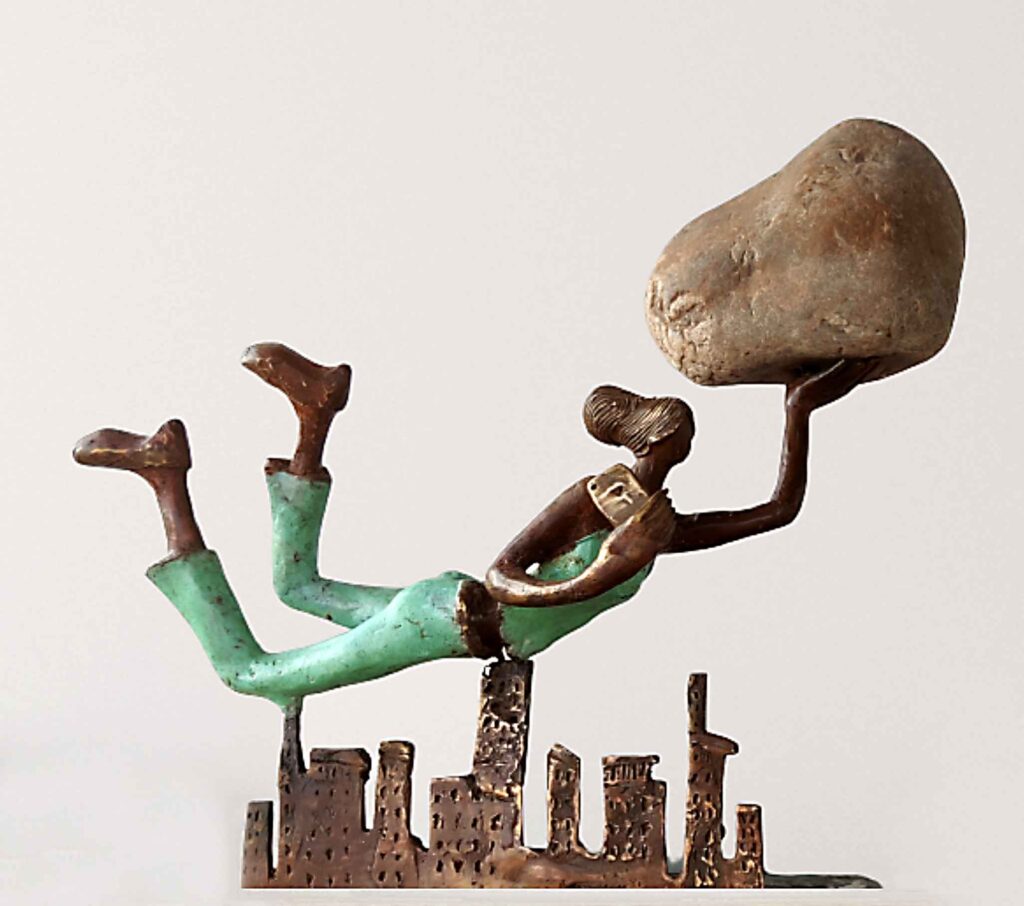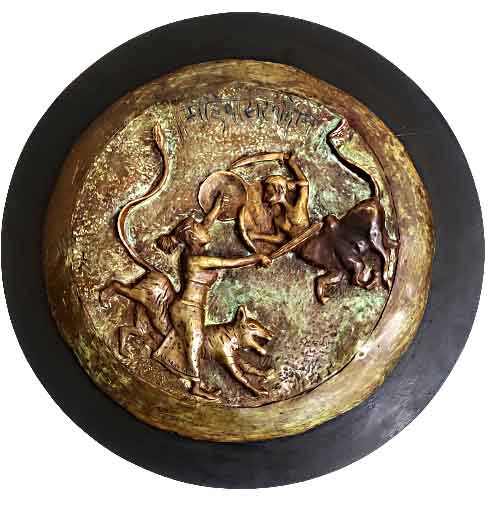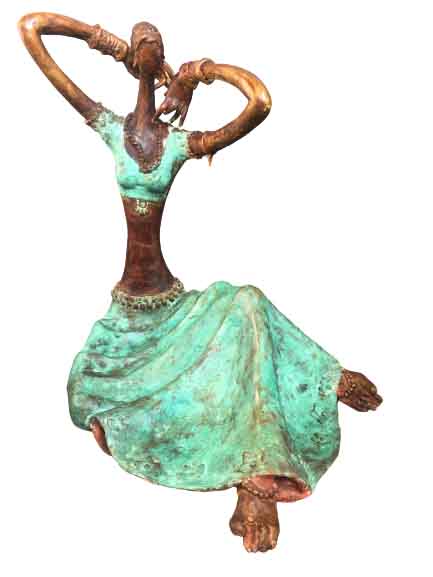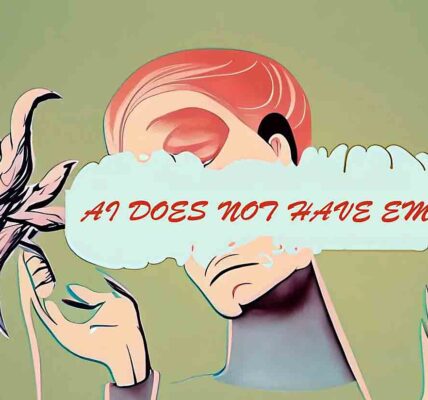Shanta’s bronze sculptures, exquisite and majestic, capture the quintessence of femininity. Her artistic journey traces the intricate path from the innocence of childhood to the wisdom of womanhood. With a profound fascination for the female persona, she embarks on a quest to explore its intricate complexity, diving deep into the heart of this enigmatic feminine phenomenon. Along her journey, she unearths a treasure trove of brilliant analogies, drawing inspiration from the timeless wellspring of classical Indian art. I first met her in the Faculty of Fine Arts, Baroda during her Master’s Degree show in 2001. Entering her display space I was immediately encompassed by her energetic and dynamic bronze figures.
In her early creations, she beautifully encapsulates the carefree innocence of childhood, painting vivid memories of a spirit unburdened by life’s complexities. These sculptures resonate with a captivating lyrical essence which like an ever-flowing undercurrent, weaves its way through her artistic journey. After we get a glimpse of the girl child and the adolescent world which blossoms over time towards sensuous adult womanhood, with slender, sensuous female figures in bronze endowed with supple elongated limbs, poised or caught in the moment of self-adornment as presented in the beautiful Shringar series which are endearing sculptures that seem to celebrate the feminine beauty and grace with unabashed abandon. But her Kalpavruksha series highlights serious issues. Here a woman is compared to a tree, where she too plays a nurturing role throughout her lifetime, always ‘giving’ shelter, protection, food and love to mankind. At the same time, she sensitively expresses her concerns for the trauma, ruthless exploitation and social hypocrisy that close the doors of progress for women, so there is a constant sense of search in her when she longs to meet the woman, who can express true ‘Naari Shakti’ and divine spirit for the fight to attain victory over evil and adversity. Where is the invisible Devi who resides in urban cities and today’s world? Such questions can always haunt the sensitive viewer when he looks at Shanta’s bronze sculptures. In Mahisasura mardini the spiritual power of the devi figure is placed at the centre, she is demolishing the evil in the form of the asura. The rich patination and dramatic display draw immediate visual appeal to the work. The bronze texture is enriched with lyrical markings. Whereas the Manuscript series is unusual in its rugged beauty and presence of ancient charm presented in a modern contest.
The other work that is most impressive is the Sanjeevani sculpture. Here Shanta has arrived at a brilliant analogy drawn from the mythological story of Hanuman. In Shanta’s sculpture, a female figure is shown flying over a cityscape with a mountain in one hand and a mobile in the other hand. Here Shanta has emphasized today’s women in multi-tasking roles, rushing through each day to meet the demands of her home family and friends. Sometimes she too faces situations where she has to take up uphill tasks, the mountain on her one hand represents the mountain of responsibilities, while the mobile on the other hand represents the modern tool to meet the demands of her workplace, and so she has to always remain ‘available’ and ‘connected’ to her family, friends, and colleagues and the world at large in the urban setup where multitasking activities are part of a daily life in today’s reality. Shackled is another brilliantly created sculpture that presents a beautiful, sensuously voluptuous woman adorned with flowers in her hair. She is seen wearing an invisible diamond necklace that symbolically gets transformed into an iron chain or shackles, which keeps her tied to her husband, for whom she is more of a showpiece, to display his wealth, authority, and proud ownership rather than be his true lover. This gift is more of a control weapon than the expression of true love in a conjugal relationship. So Shanta’s sculpture reflects on today’s social hypocrisy, which again makes the modern woman a victim in the situation, and she carries the inner hunger for ‘freedom’ which is symbolically expressed in the sculpture. Freedom is another monumental public sculpture done in stainless steel that stands with open hands under the sky in Harni Sculpture Park near the Vadodara airport. It creates a magic of wonderful reflections due to the open sky; the changing sunlight throughout the day brings out all the sheen and glamour of stainless steel. Here is a sculpture of a woman, resilient and strong as steel, who stands and releases birds towards the open sky, which again symbolically represents her dreams. She stands with strong willpower to dream and does everything to realise her dreams without fear and with full determination, so it has rightly been titled Freedom. Shanta is a young contemporary sculptor, and despite her teaching profession at MS University Baroda in the sculpture department, she is prolific in her creative output. She has also organized several workshops on terracotta, raku, dokhra, glass, and ceramics and also participated in them. At present, she lives and works in Baroda. Conversing with her on many issues related to her creative quest was indeed a pleasure and gave us a deep insight into Shanta’s artistic Odyssey.
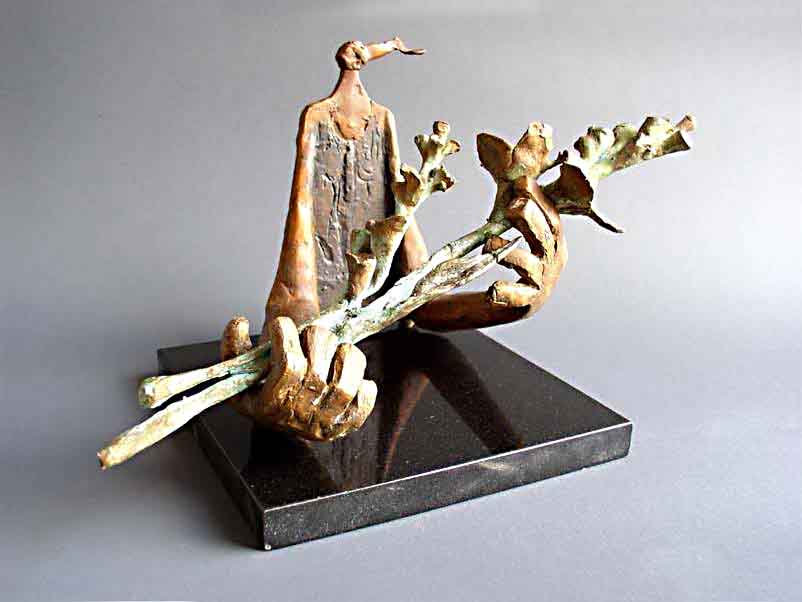
INTERVIEW
—————————————————————————————————–
Sumati Gangopadhyay: How would you recount your childhood experiences, including your fondest memories, remarkable anecdotes, and inspiring events?
Shanta: I was born into a Bengali middle-class family in Haldia township, where my father worked for the Indian Oil Corporation Limited. My early years were marked by happiness and carefree days, surrounded by my two elder sisters and a supportive family atmosphere that fostered a love for music, dance, and art. While my sisters chose music and dance, I embraced painting as my hobby. The initial reason for this choice was the timing of music and dance classes, which conflicted with our playtime. I cherished those free moments too much to give them up. I was fortunate to have understanding and loving parents who made decisions through open discussions and a strong sense of democracy within the family. Although I pursued art, it didn’t stop me from exploring clay work. I once obtained riverbank clay and created my first sculpture when I was in 2nd standard which was a portrait of Goddess Durga. My parents were deeply impressed, and their admiration served as a great source of motivation for me.
My memories of Haldia township are also filled with images of lush greenery and the enchanting seasonal blooms of flowering trees like Gulmohars, yellow laburnum, and Jacaranda. Our childhood was marked by the freedom to play, roam around, and amuse ourselves with games, music, dance, reading, or singing. It was from these carefree days that I drew inspiration for my series titled “Faded Memories.” This collection captures the boundless energy of children and reflects their youthful innocence, passion, and zest for life. Within these sculptures, one can perceive a delicate balance, harmony, and a tremendous sense of movement, often evoking anticipation and an aspiration to realize the sublime beauty of nature. The viewer is transported into a poignant reminder of lost innocence and the pleasures of childhood, with an array of figures engaged in activities such as jumping, skipping, skating, and riding, seemingly defying gravity. In 1990, I relocated to Baroda when my father received a transfer to the Gujarat Refinery as a Project Manager. I was in the ninth grade at the time. Following my completion of high school with a focus on the science stream, I lost my motivation to continue down that path and joined Fine Arts instead.

SG: I understand you had a science background before u joined the M.S.U Fine Arts faculty, Baroda. Did this science background help you in your artistic work?
S: Indeed, my background in science proved to be quite advantageous in my artistic work. This was particularly evident in the realm of sculpture, where numerous technical processes come into play. My scientific knowledge provided me with a deeper understanding of the chemical aspects involved in my art, especially the Metal casting and patination process. It also influenced my ability to work with precision and maintain the necessary discipline to achieve accurate and consistent results.
SG: What is your preferred medium for your artistic work?
S: While I have explored various artistic mediums, I hold a deep appreciation for bronze due to its timeless quality. The nature of the figures I create lends itself perfectly to bronze casting. Achieving a beautiful patina on bronze is a challenging yet enjoyable task, as art is often filled with delightful surprises and happy accidents. Additionally, I find bronze to be a strong and exceptionally beautiful medium for my art.
SG: What were your sources of inspiration for your artistic work?
S: My primary source of inspiration has always been Classical Indian art, encompassing both painting and sculpture. I found great insight and understanding through the study of miniature paintings and manuscripts, such as The Mahimnastava, an illustrated book, and manuscripts like the Soundarya Bahari. These sources allowed me to delve into the subtle nuances found within classical Indian art.
Additionally, I draw inspiration from temple sculptures, particularly the depictions of Mahishasura Mardini. These sculptural forms possess a captivating blend of power, simplicity, and abstraction. The themes of ‘Naari Shakti’ (the power of women), the eternal struggle between good and evil, and the joyous celebration of the triumph of goodness over evil have also been instrumental in guiding my creative process. These ideas have driven my work, particularly during times of conflict and turmoil in today’s world.
SG: Could you share your perspective on how the depiction of Mahishasura Mardini has influenced your core artistic concepts?
S: In my recent works, I found inspiration in temple sculptures, particularly in the formidable yet elegantly simple and abstract representations of Mahishasura Mardini. This imagery resonated deeply with me, as it encapsulates the essence of ‘Naari Shakti’ – the power of women. The eternal struggle between good and evil, embodied in these sculptures, and the supreme triumph of Goodness over Evil, served as profound sources of inspiration. I felt compelled to create my own body of work, drawing from these themes, especially in the context of the ongoing conflicts and challenges in today’s world.
SG: Which master sculptors have left a strong impression on you, and whose sculptures do you admire?
S: I hold Picasso in high regard for his remarkable versatility and innovative spirit. His ability to experiment across various mediums, even incorporating found objects in his art, is truly inspiring. Picasso’s diverse styles and techniques, which range from one work to another, demonstrate his exceptional talent.
Henri Matisse is another artist whose work has deeply moved me, particularly his masterpiece Dance. This piece captures a moment of pure, unbridled freedom and joy as figures whirl around in space while holding hands.
I must also mention the renowned Scottish Sculptor, Andy Scott, whose enormous, larger-than-life sculptures left a lasting impression on me during my visit to his studio as part of a Commonwealth project in 2012. The monumental scale of his works is awe-inspiring, and it was an extraordinary experience to meet the artist in person. Andy Scott’s dedication and his hands-on approach to working on such massive sculptures, often single-handedly, showcase his incredible skill, passion, and relentless work ethic.
SG: Shanta, I’d love to hear about your favourite Contemporary Indian sculptors and whose works you admire as well.
S: I hold great admiration for Ram Kinker Baij from Shantiniketan, mainly for the raw energy and dynamic movement captured in his sculptures. Equally, I have immense respect for my Guru, Prof. Raghav Kaneria, whose work, particularly his magnificent Bull, exudes astonishing power and fluidity in its movements. His sculptures are profoundly lyrical and reflect his rural background. Furthermore, I want to mention my distinguished teacher, the internationally acclaimed Prof. Dhruva Mistry. During my master’s degree, I had the privilege of studying under his guidance. The sculpture that I admire the most from his repertoire is his reclining figure sculpture. Observing his work ethic and unwavering dedication was a truly inspiring experience. Many of his sculptures exhibit a sensuous and majestic presence, whether placed indoors or in open spaces. An especially delightful discovery for me was his sculpture Diagram of an Object in the Hunterian Art Gallery in Glasgow, Scotland.
As for internationally renowned female contemporary artists, I greatly appreciate the work of Louise Bourgeois. Her sculptures and installations challenge the objectification of female forms and reassert the female body as a subject of artistic exploration rather than mere objectification. Her art celebrates the complexity and power of the female form, with her iconic piece Maman, which means ‘mother’ in French, being rich in symbolism and profoundly meaningful.
SG: What are the current issues and considerations you, as an artist, are focused on?
S: In the present day, the world finds itself in a state of turmoil, marked by a multitude of pressing concerns that artists are compelled to address. These include significant social and political issues, with the ongoing conflicts in Ukraine and Russia, as well as the conflict between Israel and the Gaza Strip, demanding our attention. Environmental sustainability has taken centre stage in the art world, reflecting the growing global awareness of ecological challenges. Artists are increasingly drawn to environmental themes, reflecting their commitment to promoting sustainability.
In addition, artists are recognizing the need to engage with issues related to mental health and well-being, both in their own lives and as subjects of artistic exploration. The advent of technology and the rise of digital art present new opportunities and challenges. Many artists are experimenting with digital art forms, and virtual reality, and using the internet as a platform for their work. Contemporary society grapples with an identity crisis, particularly among the younger generation. Artists are actively exploring various facets of identity, including considerations of race, gender, sexual orientation, and ethnicity. They aim to contribute to the ongoing discourse on these topics and shape the art world accordingly. There is also a dedicated effort among artists to make art more accessible to all, whether through public art installations, community engagement, or advocating for affordable art education. These artists are committed to breaking down barriers to artistic participation. Furthermore, contemporary artists use their work to address issues such as censorship and freedom of expression, globalization, and cultural exchange, and embrace interdisciplinary approaches to create meaningful dialogues and connections.
Conclusion
Shanta’s journey through art is a testament to the ever-evolving, vibrant, and socially engaged nature of the artistic world. Her insights illuminate the profound impact of art on society, its ability to address contemporary challenges, and its capacity to celebrate the beauty and complexities of contemporary women’s lives.
Read More>> Please Subscribe our Physical Magazine
